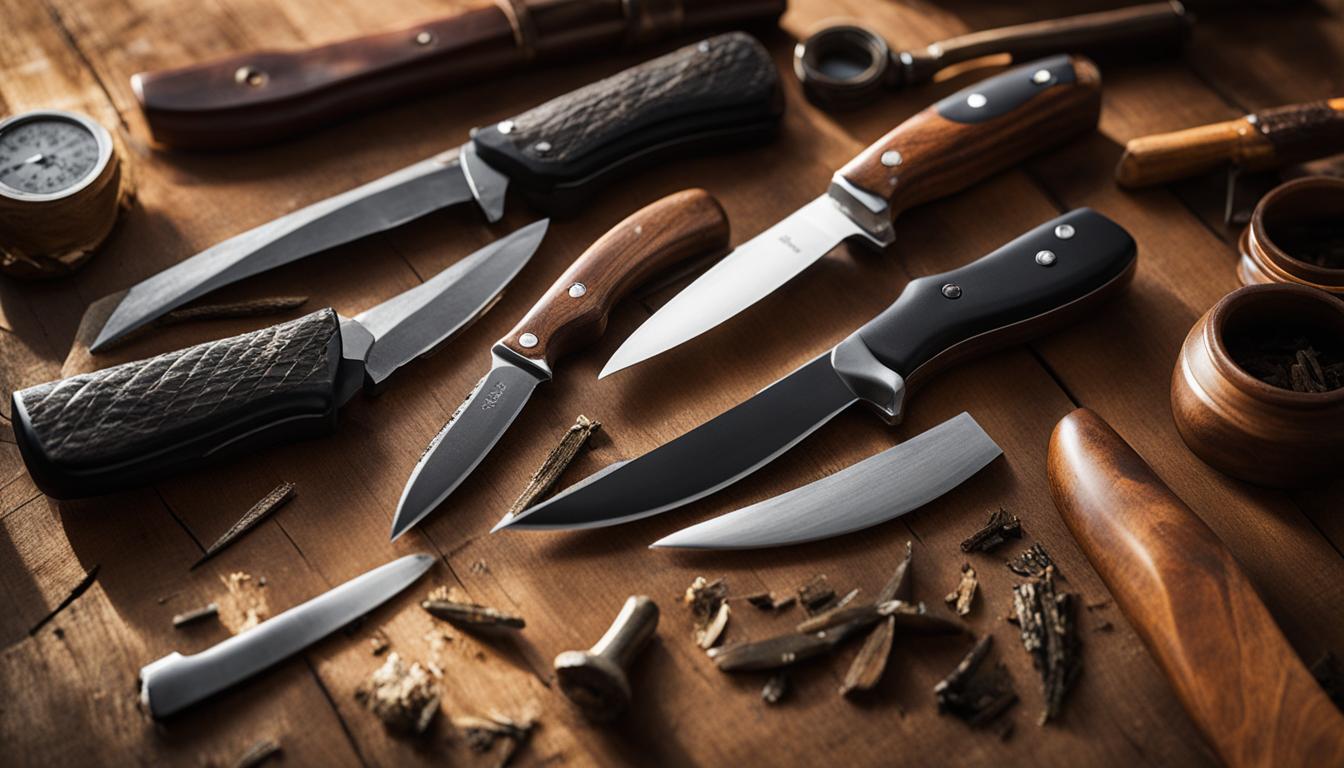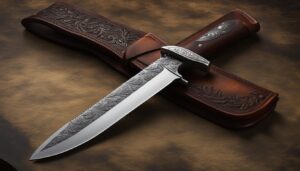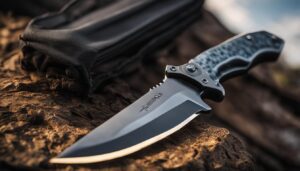When it comes to choosing a hunting knife, the weight plays a crucial role in determining its functionality and user experience. Finding the perfect balance is essential to ensure optimal comfort and efficiency during your hunts. In this article, I will guide you through the factors to consider when selecting the weight of your hunting knife.
Key Takeaways:
- Consider the intended use of the knife to determine the ideal weight.
- Blade length affects the overall weight, with longer blades being heavier.
- Blade material contributes to the weight, with stainless steel being heavier compared to carbon steel.
- Handle material also influences the weight, choose one that provides a balance between weight and functionality.
- Research and handle different knives to find the one that feels right for you.
Factors to Consider When Selecting the Weight of Your Hunting Knife
When choosing a hunting knife, one of the most important factors to consider is the weight. The weight of a knife can greatly impact its functionality and user experience. To ensure you make the right choice, here are some key factors to consider when selecting the weight of your hunting knife.
Intended Use
The intended use of your hunting knife plays a significant role in determining the ideal weight. Different hunting tasks may require different weights. For tasks that require more force, such as gutting an animal, a heavier knife may be preferred. This added weight provides better control and ensures efficient cutting. On the other hand, for tasks like whittling or general outdoor use, a lighter knife may be more suitable. This allows for easier handling and maneuverability, minimizing fatigue during prolonged use.
Blade Length
The length of the blade is another factor to consider when selecting the weight of your hunting knife. Longer blades tend to be heavier, while shorter blades are typically lighter. Longer blades offer more versatility and can handle a wider range of tasks. However, they may be bulkier and less convenient for storage and carrying. Shorter blades, on the other hand, are lightweight and easy to handle. They are ideal for tasks that require precision and agility. Consider the trade-off between blade length and weight to find the right balance for your needs.
Handle Material
In addition to blade length, the material used for the handle can also contribute to the overall weight of the hunting knife. Different handle materials have different weights and characteristics. Wood handles, for example, are lightweight and provide a comfortable grip. They are a popular choice among hunters. Other materials like bone or pearl may add aesthetic appeal but may have different weight considerations. Select a handle material that suits your preferences and provides a good balance between weight and functionality.
By considering these factors – intended use, blade length, and handle material – you can better determine the weight that will best suit your hunting needs. Remember, finding the right balance is crucial for your comfort and efficiency during hunts. Take the time to research and handle different knives to ensure you choose the one that feels right for you.
The Impact of Blade Length on Knife Weight
When considering the weight of a hunting knife, one crucial factor to examine is the length of the blade. The blade length directly influences the overall weight of the knife, which can have significant implications for its usability and performance. Longer blades tend to be heavier, while shorter blades are generally lighter.
Opting for a longer blade offers certain advantages. A longer blade provides versatility and can handle a wider range of tasks. It provides a longer reach and can efficiently tackle tasks such as skinning, filleting, and slicing game. However, it’s important to note that longer blades may be bulkier and less convenient for storage and carrying.
On the other hand, shorter blades have their own benefits. They are lightweight and easier to handle, making them ideal for tasks that require precision and maneuverability. Shorter blades are particularly well-suited for activities like caping or detail work that necessitate a delicate touch. However, their limited length may restrict their usefulness in certain situations.
Ultimately, the choice between blade length and weight largely depends on personal preference and the specific hunting tasks you anticipate. It’s crucial to consider the trade-off between the advantages of longer blades and the convenience of shorter blades. By evaluating your intended use and the physical demands you anticipate, you can determine the optimal balance between blade length and weight for your hunting knife.
Comparison of Blade Lengths and Weights
| Blade Length | Weight |
|---|---|
| 3 inches | 5 ounces |
| 5 inches | 8 ounces |
| 7 inches | 12 ounces |
| 9 inches | 16 ounces |
| 11 inches | 20 ounces |
Blade Material and its Impact on Knife Weight
When choosing the weight of your hunting knife, one crucial factor to consider is the material of the blade. The blade material not only affects the knife’s durability and sharpness but also plays a role in determining its weight. Different blade materials have varying densities and weights, which can significantly impact the overall feel and performance of the knife.
One common blade material used in hunting knives is stainless steel. Stainless steel blades are known for their durability and resistance to corrosion, making them a popular choice among hunters. However, stainless steel tends to be heavier compared to other materials. This added weight can provide stability and solidity to the knife, but it may also affect its maneuverability and portability.
On the other hand, carbon steel is a lighter alternative to stainless steel. Carbon steel blades are known for their exceptional sharpness and edge retention. They are also more resistant to wear and tear. Due to their lighter weight, carbon steel knives offer increased agility and ease of handling. However, it’s important to note that carbon steel knives may require more maintenance to prevent rusting.
“The choice of blade material ultimately depends on your personal preferences and the intended use of the knife. If you prioritize durability and don’t mind the additional weight, stainless steel might be the ideal choice. However, if you prefer a lighter and more agile knife, carbon steel could be the better option.”
When selecting the weight of your hunting knife, take into account your specific needs and preferences. Consider the tasks you will be performing with the knife and the level of comfort and control you desire. By carefully considering the blade material, you can find the perfect balance between weight and functionality for your hunting adventures.
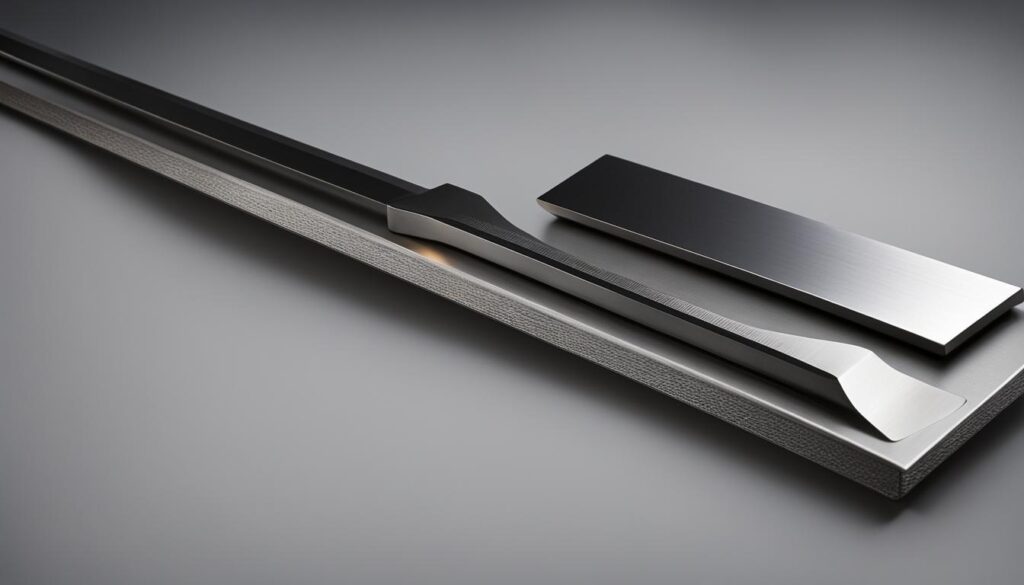
| Blade Material | Weight | Durability | Sharpness | Resistance to Corrosion |
|---|---|---|---|---|
| Stainless Steel | Heavier | High | Good | High |
| Carbon Steel | Lighter | High | Excellent | Moderate |
Handle Material and its Impact on Knife Weight
When it comes to the weight of a hunting knife, one often overlooked factor is the material used for the handle. While it may not seem significant, the choice of handle material can actually have a noticeable impact on the overall weight and balance of the knife. Different handle materials have varying densities and properties, which can affect how the knife feels in your hand during use.
One popular handle material is wood, known for its lightweight nature and comfortable grip. Wood handles provide a natural feel and are favored by many hunters for their aesthetic appeal and traditional look. Some common types of wood used for knife handles include walnut, birch, and rosewood. These materials not only contribute to a lighter weight but also offer durability and resistance to moisture.
Alternatively, other handle materials like bone or pearl can add unique visual accents to the knife, but they may come with different weight considerations. Bone handles, for example, are relatively lightweight and provide an excellent grip, making them suitable for various hunting tasks. Pearl handles, on the other hand, add elegance to the knife but can be slightly heavier compared to other materials.
When selecting the handle material for your hunting knife, it’s important to consider your personal preferences and the intended use of the knife. Whether you prioritize comfort, aesthetics, or a combination of both, choosing the right handle material can contribute to a well-balanced and functional hunting knife that suits your needs.
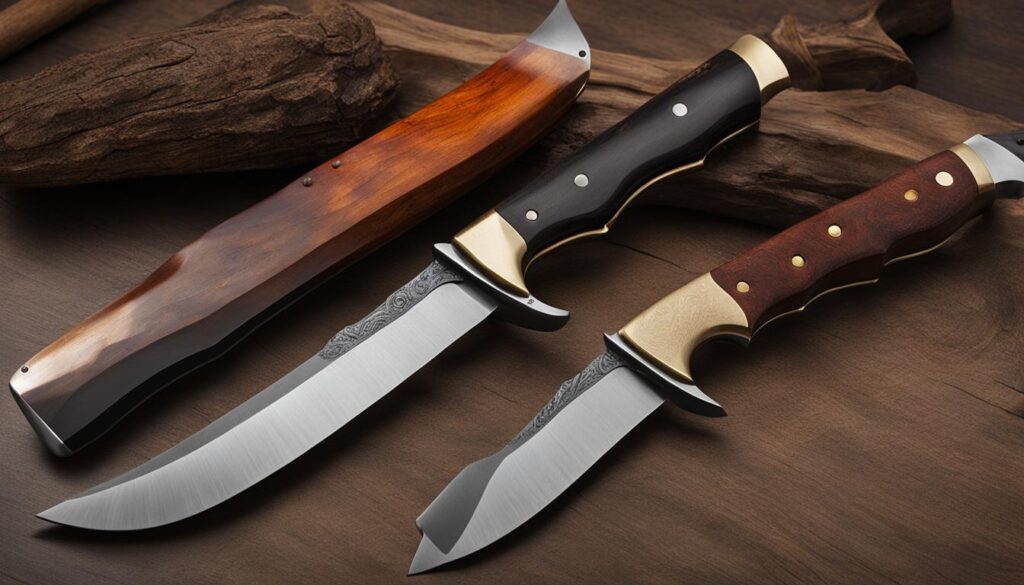

Table: Handle Material Comparison
| Handle Material | Weight | Grip | Durability | Aesthetic Appeal |
|---|---|---|---|---|
| Wood | Lightweight | Comfortable | Durable | Traditional |
| Bone | Lightweight | Excellent | Durable | Natural |
| Pearl | Slightly heavier | Good | Moderate | Elegant |
Conclusion
When it comes to choosing the weight of your hunting knife, several factors should be taken into consideration. The intended use of the knife, the length of the blade, the material of the blade, and the material of the handle all play a role in determining the best weight for you.
By understanding your specific needs and preferences, you can find the perfect balance that enhances your comfort and efficiency during hunts. Remember, a hunting knife is an investment, so it’s important to choose wisely to ensure it meets your needs for years to come.
Take the time to research and handle different knives, considering their weight and how they feel in your hand. This hands-on approach will help you make an informed decision and select the hunting knife that feels right for you.
So whether you’re gutting up an animal or whittling by the campfire, finding the ideal weight for your hunting knife will ensure that you have a reliable tool in your hands for all your hunting adventures.
FAQ
What factors should I consider when selecting the weight of my hunting knife?
When choosing the weight of your hunting knife, it’s essential to consider factors such as the intended use, blade length, blade material, and handle material.
How does blade length affect the overall weight of a hunting knife?
Longer blades tend to be heavier, while shorter blades are typically lighter. It’s important to consider the trade-off between blade length and weight, as longer blades offer more versatility but may be bulkier to carry and store.
What is the impact of blade material on the weight of a hunting knife?
Different blade materials have different densities and weights. Stainless steel blades are heavier, while carbon steel blades are lighter. Consider your preferences and intended use when choosing the blade material.
How does handle material contribute to the weight of a hunting knife?
The handle material can affect the overall weight of a hunting knife. Wood handles tend to be lightweight and provide a comfortable grip. However, other materials like bone or pearl may have different weight considerations. Choose a handle material that suits your preferences and provides a good balance between weight and functionality.
How do I choose the right weight for my hunting knife?
To choose the right weight for your hunting knife, consider factors such as your intended use, blade length, blade material, and handle material. Research and handle different knives to find the one that feels right for you.
